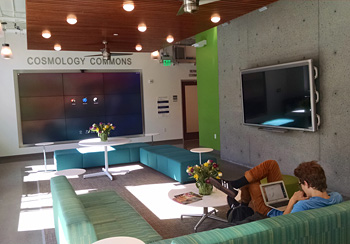Astronomers, physicists celebrate as Campbell Hall rises again
On Thursday, Feb. 12, the campus celebrated the resurrection of Campbell Hall, the home of the astronomy department with a literal and figurative bridge to the physics department. Aside from new offices & classrooms, the building houses a new precision measurement lab and a new telescope and teaching observatory.

February 18, 2015
A rebuilt Campbell Hall, which was dedicated last week, is all about bridging the gap between astronomers and physicists, and has a new open-air bridge to LeConte Hall and the physics department to cement that connection.
Scientists joined friends, donors and administrators on Thursday, Feb. 12, to celebrate the building’s resurrection, with the addition of a new precision measurement lab in the basement and a new telescope and teaching observatory on the sixth floor.
“New Nobel prizes will be won because of this building,” predicted Mark Richards, a professor of earth and planetary science who, as executive dean of the College of Letters and Science until last year, oversaw most of the fundraising and planning for the renovation. He and new physical sciences dean Frances Hellman, a professor and former chair of physics, thanked alumni donors, architects and legislators who helped make the project a reality.
“This is not just about cosmology and science,” Richards reminded the audience. “We are not a degree factory, we are not here primarily for cost control, we are not here to turn out widgets and to make our instruction efficient, we are here to inspire students.”
One of those students is former Assemblymember Nancy Skinner, who was instrumental, along with fellow alums U.S. Rep. Barbara Lee and former Assembly Speaker John Perez, now a UC regent, in getting $71 million in state funding to complete the $80 million facility.

Astrophysicist Bernard Sadoulet and astronomer Dave DeBoer inspect a brand new telescope built by Dick Treffers for the teaching observatory on the 6th floor of the rebuilt Campbell Hall. (UC Berkeley photo by Robert Sanders)
The project was also made possible by a rare $11 million grant from the National Institute of Standards and Technology, part of which funded the construction of the underground Center for Integrated Precision and Quantum Measurement, where scientists can conduct sensitive experiments free of the noise and vibrations typical of most laboratories.
The original building, completed in 1959, was named for the astronomer and 10th UC president William Wallace Campbell, who directed Lick Observatory for more than 20 years and helped create the world-class department that now occupies the building, noted Chancellor Nicholas Dirks.
A copy of an oil portrait of Campbell has graced the walls of the department’s office for decades, but the original was misplaced until it was recently unearthed in the campus’s archives and restored by the family. The refreshed painting was unveiled Thursday and is now on permanent display in the Morrison Library in Doe Library, while an exhibit about Campbell’s accomplishments opened last week on the fifth floor of Campbell Hall.

Cosmology Commons, a Campbell Hall satellite of the Berkeley Center for Cosmological Physics, which is a short bridge walk from the main center in LeConte Hall. The commons was sponsored by the Heising-Simons Foundation. (UC Berkeley photo by Robert Sanders)
Along with modern classrooms and research labs, the building houses a new third-floor Cosmology Commons – part of the Berkeley Center for Cosmological Physics in LeConte Hall – sponsored by the Heising Simons Foundation.
“This is historic for our department and for the campus,” said planet hunter Geoff Marcy, a professor of astronomy.
The old building was demolished in 2012 to modernize the facility and because it was rated seismically poor. The new building, at 82,000 square feet, was designed by Studios Architecture to achieve the U.S. Green Building Council’s LEED silver rating. The Campbell Hall project team, which completed the building on time and under budget, also included general contractor Hunt Construction Group and UC Berkeley’s Capital Projects office.
RELATED INFORMATION